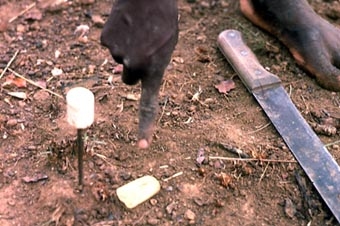Translations:
Other Pages:
CEC Training Modules
Akan Studies Site Map
Sociology for beginners
Contact
Kompan Adepa
Go to the People
Ghana Web
Kwawu Prehistory
by Phil Bartle, PhD
The earliest human inhabitants of what is now Kwawu were gatherers and hunters. They were apparently people who were living all across Africa prior the appearance and spread of what we now call Black Africans. Residuals of these people are today to be found among the Khoisan of the Kalahari and the pygmies of Congo and Uganda. Black Africans, who originated around Lake Chad, were farmers, and they pushed the earlier hunters and gatherers to the most marginal lands, deserts and swamps, not optimum for farming. This is similar to the marginalisation of First Nations gatherers and hunters when the Europeans came to North America. This process continues today in the discrimination and maltreatment of Pygmies in Uganda and Congo, and of the Khoisan, called "Bushmen" by southern Africans.
While the earliest inhabitants may or may not have built shelters, biodegradable materials did not last in the rain forest because of the rainfall. These humans did, however, live in caves, and there are many caves in Kwawu, and all have archaeological evidence of early inhabitation.
About 5,370 years ago, the agricultural revolution arrived in Kwawu in the form of immigrants who were farmers rather than gatherers. This is shown in the caves where tools made out of rocks from outside the region indicated trade and communication. The Afram River, running from Northwest to Southeast, was on a major route between the savannah and the coast. Unlike previous tools, many made of flaked slate, the new farm tools were made of polished stone, indicating a more sedentary society, in contrast to the earlier gatherers.
 |
Nyame Akuma, Nyame Aso (God Hoe, God Axe) Polished Stone Tool
This time coincides with that of Davies who wrote of between approximately 3,500 BCE and 3100 BCE when the appearance of pottery and smooth stone tools appeared throughout West Africa. Perhaps this was the arrival of what we now call Black Africans.
We are talking about a period of history that long precedes the earliest oral traditions in Kwawu. Current stories about the Mmoetia, or "dwarves," may be residuals from the time of these early gatherers and hunters.
The arrival of the farmers and the earlier residence of the gatherers indicate that there was some overlap between them. The gatherers were forest dwellers, shy, and furtive. They were not well known by the farmers, and various myths and stories were invented to explain them. The stories were passed down by the farmers over the centuries and are known to us now as the mmoetia, or "dwarves." Today the people themselves do not appear to exist, either they were chased way, killed, or intermarried, perhaps a bit of all three. Modern stories describe them as being small, red skinned, with knees that bend backwards. Only the latter description does not coincide with the characteristics of the Khoisan.
I was doing my research in Kwawu in the seventies when I met Andrew Smith, an archaeologist looking at Bosumpra Cave near Abetifi where Shaw had excavated in 1944. Smith sent carbon remains of oil palm seeds and old cooking fires to the Kew biological gardens in the UK and had them carbon 14 dated. It was he who discovered that the oil palm was originally a small fruit but became larger over the centuries because of selective breeding (See Palm). Pra is an important tutelary spirit in Kwawu, and the God is seen to inhabit the Pra River and flows from the Kwawu escarpment south to the coast entering the ocean between Cape Coast and Takoradi. One of the akomfo of Obo is possessed by Obosom Pra.
We cannot say for sure yet if the earliest farmers were Guan speakers or not. It is unlikely because the expansion of the Guan appears to be a result of the break up of the Ghana Empire, several thousand years later. There may have been several waves of immigrants to Kwawu before the arrival of the Guan; that is most likely. Generally, however, when newcomers arrive, they recognise the earlier gods, spirits of the rivers and caves, so the names of the gods, and the mmoetia, are passed down to us today.
The caves were used as residences well into the Guan era and then partly into the Akan era, until about 750 years ago, plus or minus 75 years ago. Today they are used for ritual and religious purposes, seen as the habitats and shrines of local tutelary spirits.
Footnotes:
1. C.T. Shaw, 1944, Report on excavations carried out in the cave known as 'Bosumpra' at Abetlfi, Kwahu, Gold Coast Colony, Proceedings of the Prehistoric Society. Volume 10, page 1
2. Andrew B. Smith, 1987, Radiocarbon dates from Bosumpra Cave, Abetifi, Ghana. Proceedings of the Prehistoric Society. Volume 47, page 179
3. O. Davies, Archaeology in Ghana. Thomas Nelson
4. Andrew Smith, op cit. From his research at Bosompra Cave near Abetifi